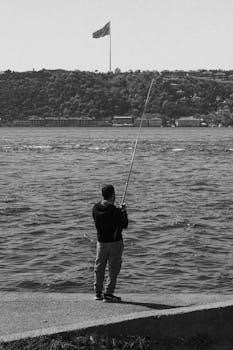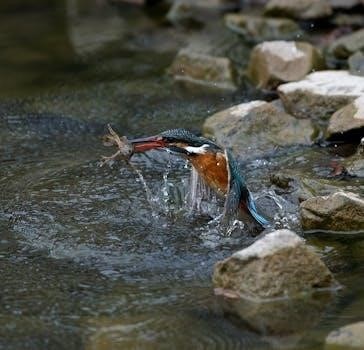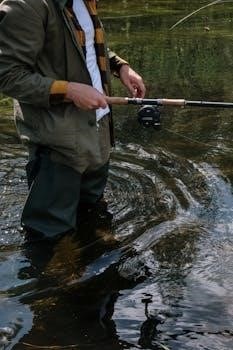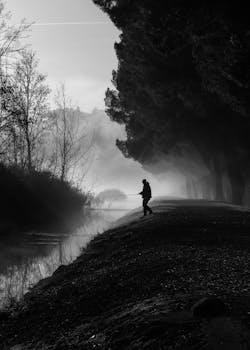Fly Fishing the White River in Arkansas⁚ A Comprehensive Guide
The White River in Arkansas, nestled in the Ozark Mountains, stands as a premier fly-fishing destination. This comprehensive guide unlocks angling marvels, offering insights into tackling trophy brown trout and rainbow trout in its waters.
Fly fishing the White River in Arkansas is more than just a pastime; it’s an art form demanding skill and preparation. The White River, flowing from Bull Shoals Dam to Cotter, offers year-round action due to its temperate climate sustained by the dam. The river’s prolific bug life supports excellent trout fishing, making it a destination for anglers seeking trophy browns and plentiful rainbows. Public access is excellent, catering specifically to fly fishers.

Understanding the White River Ecosystem
To master fly fishing on the White River, understanding its ecosystem is key. From the river’s flow influenced by Bull Shoals Dam to its diverse insect life, each element plays a vital role.
The Role of Bull Shoals Dam
Bull Shoals Dam profoundly shapes the White River’s trout fishery. The dam’s water releases dictate river levels, influencing insect activity and trout behavior. These fluctuating water levels impact where trout concentrate, influencing fly fishing strategies. The cold, consistent flows from the dam create ideal conditions for trout survival and growth, contributing to the river’s reputation for trophy-sized fish. Understanding generation schedules is vital for planning safe and successful fly fishing trips.
Insect Life and Trout Diet
The White River boasts a diverse aquatic ecosystem, crucial to the trout’s diet. Sowbugs and scuds thrive year-round, forming a consistent food source. Mayflies and stoneflies provide seasonal hatches, triggering feeding frenzies. Matching the hatch with appropriate fly patterns is essential for success. Trout also feed on smaller baitfish and crustaceans. Observing insect activity and understanding the trout’s dietary preferences are key to selecting effective fly patterns and presentation techniques for a successful fly fishing experience.
Essential Gear for White River Fly Fishing
Success on the White River requires specific gear. This section details the necessary fly rods, reels, lines, waders, boots, and fly selection to effectively target trout.
Fly Rods, Reels, and Lines
Selecting the right fly rod, reel, and line is crucial for White River success. A 9-foot, 5 or 6-weight rod is versatile for various techniques. Match the rod with a quality reel featuring a smooth drag system. Choose weight-forward floating lines for general use, and consider sinking tip lines for nymphing deeper runs. Leaders and tippets should be fluorocarbon for low visibility.
Waders and Boots for the White River
Waders and boots are essential for navigating the White River’s cold waters. Neoprene waders offer warmth in winter, while breathable waders are comfortable in warmer months. Choose boots with felt or rubber soles, and consider adding studs for extra traction on slippery rocks. Wading staffs provide stability and safety in swift currents. Always prioritize safety when wading.
Fly Selection⁚ Matching the Hatch
Success on the White River hinges on matching the hatch. Observe insect activity to determine the prevalent food sources. For scuds and sowbugs, use patterns like the Sowbug Nymph or the Ray Charles. Mayfly imitations are effective during hatches. Streamer patterns like Woolly Buggers and Sculpins work well. Local fly shops provide invaluable insight on fly selection based on current conditions.

Prime Locations for Fly Fishing on the White River
The White River offers diverse fishing spots. Public access areas abound from Bull Shoals Dam to Mountain View. Each location presents unique opportunities for targeting trout, with varying water conditions and accessibility.
Fishing near Cotter, Arkansas
Cotter, Arkansas, nestled along the White River, is a renowned fly-fishing destination. Its proximity to Bull Shoals Dam ensures consistently cold, trout-rich waters. The town boasts several fly shops, like Dally’s Ozark Fly Fisher, providing gear and guidance. Anglers can access the river easily for wade-fishing or launch boats for broader exploration. Limestone outcroppings create shoals, ideal for targeting trout feeding in riffles and runs. The area supports a diverse insect population, making “matching the hatch” a key strategy for success.
Access Points and Public Fishing Areas
Arkansas offers excellent public access to the White River, catering specifically to fly fishers. Many locations provide convenient public parking, facilitating easy entry to the river. Powerhouse Road, once a prime wading area, still offers access. The state actively maintains areas for fishing, ensuring anglers can find suitable spots along the river’s extensive length. These access points range from easily wadable shoals to boat launches, accommodating various fishing styles. Familiarizing yourself with these areas is crucial for planning a successful and accessible fly-fishing trip.
Fly Fishing Techniques for White River Trout
Mastering fly fishing on the White River requires specific techniques. Adapt strategies for nymphing, streamer fishing, and even bead fishing to target trophy browns and abundant rainbows in this renowned Arkansas tailwater.
Nymphing Strategies
Nymphing is a highly effective technique on the White River due to the prolific bug life. Focus on scuds, sowbugs, and mayfly nymphs. Employ indicator nymphing or Euro nymphing techniques to maintain contact with your flies. Adjust sinker weight as water levels fluctuate to ensure your nymphs reach the trout’s feeding zone. Pay close attention to the river bottom structure and target riffles, runs, and seams where trout are likely to hold and feed, maximizing your chances of success.
Streamer Fishing for Trophy Browns
Targeting trophy brown trout on the White River often involves streamer fishing. Covering large expanses of water is crucial for locating these elusive fish. Use smaller streamers like woolly buggers or articulated patterns such as the Drunk and Disorderly. Focus on areas near drop-offs, submerged structures, and deep pools. Vary your retrieve speed and presentation to entice strikes. Winter months are prime for streamer fishing as brown trout become more aggressive during spawning season, increasing your chances of landing a monster brown.
Bead Fishing Techniques
Bead fishing on the White River is a highly effective technique, especially during the trout spawning season. This method imitates trout eggs, a prime food source during this time. Employ custom-painted beads that match the color and size of the local trout eggs. Fish the beads in areas where trout are actively spawning or have recently spawned. Use a dead-drift presentation, allowing the bead to drift naturally along the bottom. Adjust your weight to maintain contact with the riverbed for optimal success in enticing strikes from trout.

Seasonal Fishing on the White River
The White River offers year-round fly fishing opportunities due to its temperate climate. Each season presents unique conditions and tactics, influencing trout behavior and fly selection for a fulfilling angling experience.
Winter Fly Fishing for Brown Trout
Winter on the White River presents a prime opportunity to target trophy brown trout, particularly during their spawning season. Utilizing bead fishing techniques, mimicking trout eggs, becomes highly effective. Focus on covering large expanses of water with streamers, including woolly buggers and articulated patterns like the Drunk and Disorderly. Anglers should be prepared for significant temperature swings, layering clothing and checking weather forecasts before embarking on their trip.
Spring and Summer Fishing Tactics
During spring and summer on the White River, fly fishing tactics shift due to increased insect activity and changing water conditions. Matching the hatch becomes critical, observing prevalent mayflies, caddisflies, and other aquatic insects. Nymphing techniques remain effective, especially in riffles and runs. Consider using smaller streamers and sculpin imitations. Wade-fishing is often productive in shoals. Always check water levels and adjust sinker weights accordingly for optimal bait presentation.
Fall Fishing Opportunities
Fall on the White River presents unique fly-fishing opportunities as trout actively feed in preparation for winter. Streamer fishing becomes increasingly effective, targeting aggressive brown trout. Consider using larger articulated patterns to entice trophy-sized fish. Cooler temperatures often bring lower water levels, making wade-fishing more accessible. Terrestrial insects can also be productive during early fall. Observe insect activity and adjust fly selection accordingly for a successful autumn outing.
Guided Fly Fishing Trips on the White River
Explore the White River with experienced guides for all-inclusive fly-fishing adventures. These trips cater to all skill levels, offering invaluable fishing tips and access to prime locations for trophy trout.
Choosing a Reputable Guide Service
Selecting the right guide service is crucial for a successful White River fly fishing experience. Look for services with experienced guides who possess in-depth knowledge of the river, its trout populations, and effective fishing techniques. Consider guide services that offer all-inclusive packages, providing gear, flies, and transportation. Reputable guides should prioritize safety, adhere to regulations, and demonstrate a commitment to conservation. Check online reviews and seek recommendations from fellow anglers to ensure a memorable and rewarding trip.
What to Expect on a Guided Trip
A guided fly fishing trip on the White River typically includes expert instruction, focusing on casting techniques, fly selection, and reading the water. Expect your guide to provide all necessary gear, such as rods, reels, and flies, though you may bring your own if preferred. Guided trips often involve navigating the river by boat, accessing prime fishing spots. Guides will offer insights into the river’s ecology and fish behavior. Be prepared for varying weather conditions and dress accordingly. A guided trip aims to enhance your skills and increase your chances of landing trophy trout.
Regulations and Licensing for Fly Fishing in Arkansas
Fly fishing in Arkansas requires anglers to possess a valid fishing license and trout permit. Familiarize yourself with catch and release guidelines and specific regulations for the White River to ensure responsible angling practices.
Obtaining an Arkansas Fishing License and Trout Permit
To legally fly fish the White River, you must obtain an Arkansas fishing license. This can be purchased online through the Arkansas Game and Fish Commission website or at authorized retailers. Additionally, a trout permit is required to fish for trout in the White River. Ensure that you have both before heading to the river. Check the regulations for specific details, including any daily limits or restrictions.
Catch and Release Guidelines
Practicing proper catch and release is vital for preserving the White River’s trout population. Use barbless hooks to minimize injury to the fish. When handling a trout, wet your hands to protect its slime coat. Keep the fish in the water as much as possible, and avoid touching its gills. Gently remove the hook with forceps or pliers. Allow the fish to recover before releasing it.
Safety Considerations for White River Anglers
Anglers must prioritize safety on the White River. Be aware of fluctuating water levels due to dam operations. Check weather forecasts and dress appropriately. Wear a personal flotation device (PFD) and exercise caution when wading in swift currents.
Navigating River Conditions
Successfully navigating the White River requires constant awareness of its dynamic conditions. Bull Shoals Dam releases significantly impact water levels, potentially creating hazardous situations. Anglers should monitor generation schedules closely, available through the Southwestern Power Administration. Rising water can quickly submerge gravel bars and create stronger currents. Wading anglers should use a wading staff for stability and avoid areas with swift, deep water. Always inform someone of your fishing plans and expected return time. Recognizing and adapting to changing river conditions is crucial for a safe and enjoyable experience on the White River.
Weather Preparedness
Arkansas Ozark weather can be unpredictable, demanding anglers to be well-prepared. Temperature swings are common, so layering clothing is essential. A waterproof rain jacket is crucial, as sudden showers are frequent. Sunglasses and a hat will provide protection from the sun and glare. Don’t forget sunscreen, even on cloudy days. Checking the weather forecast before your trip is vital. Be ready for both warm and cool conditions by packing appropriate attire. Having the right gear will allow you to fish comfortably and safely, regardless of the weather.
Fly Tying for White River Patterns
Mastering fly tying for White River patterns enhances your angling success. Discover essential techniques for crafting effective flies. Elevate your Ozark fly fishing experience with detailed guides and tips for tying specific patterns.
Essential Patterns to Tie
For White River fly fishing, essential patterns include scuds and sowbugs, imitating the prolific bug life. Stoneflies and various mayfly species are also crucial. Streamer patterns like Woolly Buggers and sculpin imitations effectively target trophy trout. Consider larger articulated patterns such as the Drunk and Disorderly, Circus Peanut, Double Deceiver, and Hollow Point. Custom-painted beads matching trout eggs are vital when spawning trout are present, especially during winter bead fishing.

Preserving the White River Fishery
Conservation efforts are vital to maintaining the White River’s renowned trout fishery. Responsible angling practices, such as catch and release, contribute to the river’s long-term health and sustainability.
Conservation Efforts
Protecting the White River fishery involves multiple strategies. The Arkansas Game and Fish Commission plays a key role through regulations and monitoring. Anglers contribute by adhering to catch and release guidelines, minimizing disturbance to spawning areas, and properly disposing of waste. Local organizations also engage in habitat restoration and educational programs to promote responsible stewardship. These combined efforts are crucial for sustaining the White River’s exceptional trout population and ensuring its future as a premier fly-fishing destination for generations. Responsible fishing is important to maintaining the beauty and nature of the river.